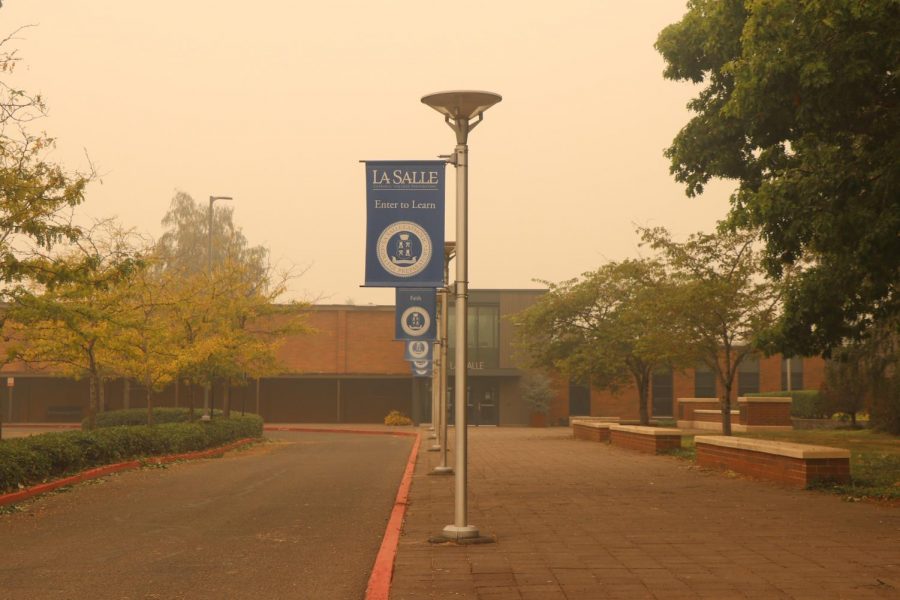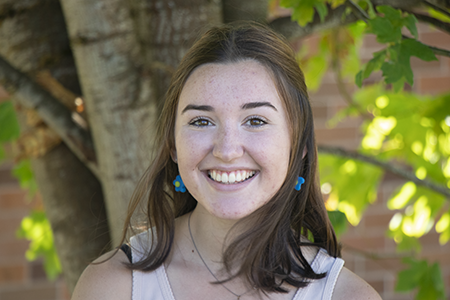Students and Staff Share Their Reactions to the Online Start of This School Year
Until the day when classes can return to in-person learning, La Salle’s campus remains quiet other than a few staff members working from classrooms and offices.
September 16, 2020
Students and staff kicked off the first day of classes through a screen this year. With muted microphones, an array of backgrounds behind classmates and teachers, and collaboration through Zoom breakout rooms, classes are much different than usual for students and staff.
This year, La Salle has moved into a synchronous schedule where students attend classes over Zoom four times a week, with Wednesday reserved for asynchronous learning to provide additional time for professional development, office hours, and other student support.
Senior Anthony Nguyen said that he “really appreciate[s]” the asynchronous Wednesday schedule, as it provides the opportunity for catching up on schoolwork, “or [to] be with clubs or do sports.”
While all students are attending Zoom classes and completing schoolwork off-campus, staff members have the option to go into the building to work from their classrooms and offices.
Spanish teacher Ms. Lisa Moran is teaching from her classroom, and plans to continue this way. She said that she wears her mask at all times, unless she is alone in her classroom with the doors closed, and she has noticed that other people in the building are doing the same.
“Those who are choosing to come in are very strictly following the protocols that the school has set for us, which I sincerely appreciate,” she said.
Working from school, rather than at home, has been helpful for religious studies teacher Mr. Banks. “I think that going to campus is a bit of a mental switch for me — it feels like a place where I should do work… working from home is harder in this regard,” he said.
Sophomores, juniors, and seniors have all had a taste of what digital learning looks like at La Salle. Despite this, some students are still experiencing the effects of uncertainty. For sophomore Sofia Burgher, going into this school year with an online schedule feels “a little bit chaotic,” she said.
However, the new synchronous schedule works in the favor of some students and teachers. Burgher said that she appreciates how the schedule provides more regularity, but that “there’s definitely some things I prefer about managing my own time… [I] feel like a whole lot of the day is wasted between classes, or just waiting.”
Mr. Banks said one of his concerns is the long-term impacts of online learning. “I think that the material that can effectively be covered online is less than what can be covered in the classroom or in person,” he said.
Some students, like Nguyen, prefer the synchronous schedule to the asynchronous work students were assigned last spring. “Personally, I like this schedule better,” he said. “This will definitely help me stay on track.” He said that having designated times for each class aids his own time management.
Ms. Moran said that she appreciates the consistency of required online sessions, as it helps hold students and teachers accountable. “I think it also helps with our communication with students,” she said.
In addition to this, Ms. Moran, who considers herself more “of a relational teacher,” said that seeing students through Zoom encourages more conversation, and allows for better connection.
Mr. Banks expressed a similar sentiment, that having “face-to-face” time with students brings a stronger sense of connection than asynchronous learning did.
For others, the synchronous schedule is challenging. For example, some students would prefer to work at their own pace throughout the day. “Everyone’s learning is different,” senior Bella Chalmers said. “In that sense, I don’t like it.”
Chalmers also has a job, and finds it challenging to work around the new schedule. “I liked it better last semester when I could literally just get my work done whenever I wanted… and still go to work at normal hours.”
Despite the situation, students shared that they have learned a few tips from last spring that will help them be successful while continuing with digital learning.
Some students said that prioritizing organization is a large factor in managing online school — whether it be through planners, calendars, or another organizational tool. Others said that it is beneficial to find and maintain a healthy sleep pattern.
According to both students and staff at La Salle, attending classes online presents challenges, but students also mentioned a bright side to the current situation.
“I’m grateful La Salle has the technology we have,” Nguyen said. “I’m looking forward to meeting people even though we’re not in person.”
Teachers are also using their available technology and new resources to help make digital learning function in the most effective way possible.
Apps such as Go Formative, which can administer assessments, and other apps like Quizlet or Jamboard are all being utilized by teachers. “You have to really rethink every lesson you teach… everything feels new and different,” Ms. Moran said. “[I’m] trying to make it more engaging and fun for students.”
Both Mr. Banks and Ms. Moran said that they felt like a first-year teacher again amidst the online adjustments. “There are so many new dynamics that it almost feels like I can’t use any of my prior experience to teach well this year,” Mr. Banks said.
Recording classes is an additional way that Mr. Banks has found to be helpful for himself and for students. He said that offering a recording of what happened in a class, or a discussion of a slideshow, is more beneficial than an otherwise brief rundown.
“I think it’s good that we learn how to use different tools and that we challenge ourselves to step outside of our comfort zone once in a while,” Ms. Moran said. “I do think it’s positive that we find new ways to relate to people.”
Chalmers also noted that teachers tend to be more available to answer questions and help students compared to a busy on-campus environment.
Many people are hoping to return to campus through a hybrid schedule. This would entail a division of students alphabetically by last name, so that there is a smaller number of students on campus on a given day, with students attending in-person classes twice a week.
“I need in-person lessons and teaching,” Rivera said. “At school is where I feel the most successful.”
For Ms. Moran, there is a bit of uncertainty as to how well the hybrid schedule would improve learning. “I think we can adapt, I know we can do it, but I’m just not sure how much more effective it would be than what we’re currently doing,” she said. With students spread out between on-campus instruction and digital learning, she said that juggling two different methods of learning in the hybrid schedule might not necessarily be more effective than continuing online.
Another downside to being away from campus is the typical social interaction between students and teachers that is difficult to replicate over Zoom. “As a senior, I was really excited to go back,” Chalmers said. “I was really excited to sit in a classroom… [I miss] being able to physically talk to teachers and ask questions.”
For teachers, returning through a hybrid schedule means a more overwhelming workload, as they would be teaching in-person lessons as well as online lessons. “I do feel that students seeing each other in person has a huge benefit on their social [and] emotional well being too,” Ms. Moran said. “So, when it comes to the time when we can [be on campus]… that would outweigh the work that I would put in.”
In hopes to maximize the social connections between students, the breakout room feature has been utilized by many teachers on Zoom. “It’s the little social interaction[s],” Chalmers said. “Those little moments when we break off into the groups… and you’re working together.”
Being on Zoom, especially in smaller groups, helps people to see that others are in the same position we are, Ms. Moran said. “We maybe intellectually knew that, but I think that sometimes seeing it and intellectually knowing it are two different things,” she said. “This way, we actually get to see that we’re in this together.”
In addition to the academic benefits of in-person learning, being at school allows for more interaction in the community. With the chance to be on campus comes more opportunities for student life.
School dances, assemblies, prom, and graduation are all events that may be affected in the long term due to social distancing guidelines. While prom and graduation are months away, “there’s definitely a possibility [that] it might not happen, so it’s something I worry about,” Nguyen said.
Chalmers also expressed her concern about being able to connect through student life, especially if people do not practice social distancing. “I’m worried that they’re going to give us an opportunity like [prom],” she said, “and we’re just going to blow it.”
The day the community will return to campus is still up in the air, and for some, it is more of a hope than an anticipated event.
“It’s so unpredictable,” Burgher said. She hopes that at least by the end of the year there will be groups allowed on campus for classes.
However, a return to campus poses a risk of infection for both students and staff. “I get worried about getting sick,” Rivera said, “but I also don’t mind going back to school with face coverings as long as people do their part to the best of their abilities.”
For Burgher, the concern lies in the question of how well students will actually follow guidelines at school. “I do trust the guidelines and that they work,” she said. “The only thing I’m worried about is people not following them.”
For student athletes, sports seasons have been adjusted by OSAA to prevent the spread of the coronavirus. Rivera in particular said that her volleyball team is able to do “small group trainings,” but the official season is not set to begin until March.
“I miss being able to go to sports games and overall just being with other people,” she said.
Until the La Salle community is allowed to convene on campus for events, athletics, or other opportunities, Nguyen hopes that students will participate in the digital events that are planned through the student life center.
“We’re trying to have assemblies, or masses or prayer services, and we really hope that students take part in that even though it might not be required,” he said. “I think it’s a big part of school pride and school spirit to be a part of those events even though we’re at home.”





